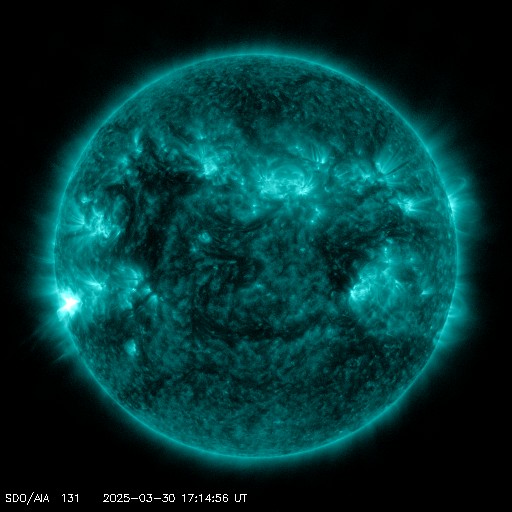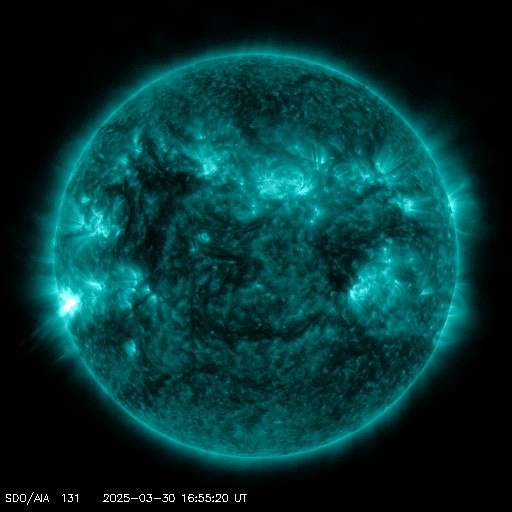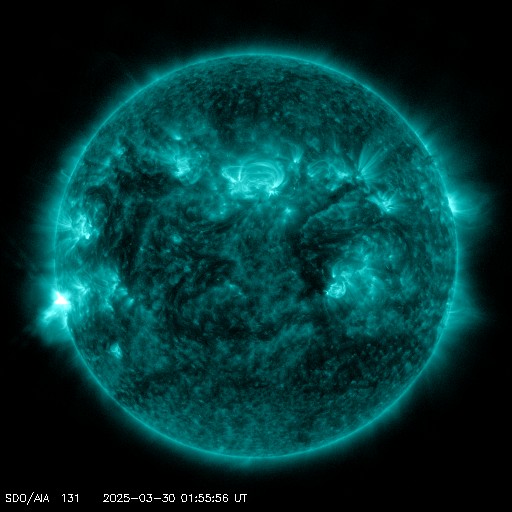Viewing archive of Saturday, 16 July 2005
Solar activity report
Any mentioned solar flare in this report has a scaling factor applied by the Space Weather Prediction Center (SWPC). Because of the SWPC scaling factor, solar flares are reported as 42% smaller than for the science quality data. The scaling factor has been removed from our archived solar flare data to reflect the true physical units.
Report of Solar-Geophysical Activity 2005 Jul 16 2200 UTC# Prepared jointly by the U.S. Dept. of Commerce, NOAA, #Space Environment Center and the U.S. Air Force. #
Joint USAF/NOAA Report of Solar and Geophysical Activity
SDF Number 197 Issued at 2200Z on 16 Jul 2005IA. Analysis of Solar Active Regions and Activity from 15-2100Z to 16-2100Z
Solar activity was at moderate levels. Region 790
(S10W80) produced an impulsive M1 x-ray flare at 16/0338Z. It was
also the source for a very long duration C7 flare that occurred
between 15/2010Z and 16/0005Z. A Type II radio sweep occurred in
association with a C2 flare that occurred at 16/0714Z from Region
790, although LASCO imagery showed little associated CME activity.
No new regions were numbered today.
IB. Solar Activity Forecast
Solar activity is expected to be at
low levels. Region 790 remains capable of producing an isolated
M-class flare.
IIA. Geophysical Activity Summary 15-2100Z to 16-2100Z
The geomagnetic field was at predominantly quiet to unsettled levels.
An active period occurred at the Boulder magnetometer between
16/0600 and 0900Z. A weak transient signature was observed at the
ACE spacecraft near 16/0100Z with no significant geomagnetic effects
resulting. The greater than 10 MeV proton event that began on
14/0245Z, had a peak flux of 134 pfu at 15/0345Z, remains
in-progress. The proton flux has been on a gradual decrease and was
near 11 pfu at the end of the period. The greater than 2 MeV
electron flux at geosynchronous orbit reached high levels again
today.
IIB. Geophysical Activity Forecast
The geomagnetic field is
expected to be at quiet to active levels. Isolated minor storm
conditions may be possible with the onset of the anticipated
transient from the CME activity that occurred on 14 July. The
greater than 10 MeV proton event is expected to end early in the
period on 17 July.
III. Event Probabilities 17 Jul to 19 Jul
| Class M | 15% | 05% | 01% |
| Class X | 05% | 01% | 01% |
| Proton | 99% | 15% | 01% |
| PCAF | yellow | ||
IV. Penticton 10.7 cm Flux
Observed 16 Jul 076 Predicted 17 Jul-19 Jul 075/075/075 90 Day Mean 16 Jul 097
V. Geomagnetic A Indices
Observed Afr/Ap 15 Jul 004/006 Estimated Afr/Ap 16 Jul 008/008 Predicted Afr/Ap 17 Jul-19 Jul 010/012-005/010-008/008
VI. Geomagnetic Activity Probabilities 17 Jul to 19 Jul
| A. Middle Latitudes | |||
|---|---|---|---|
| Active | 20% | 15% | 20% |
| Minor storm | 10% | 05% | 05% |
| Major-severe storm | 05% | 01% | 01% |
| B. High Latitudes | |||
|---|---|---|---|
| Active | 30% | 20% | 20% |
| Minor storm | 15% | 10% | 05% |
| Major-severe storm | 05% | 05% | 01% |
All times in UTC
Current data suggests there is a slight possibility for aurora to appear at the following high latitude regions in the near future
Norilsk, VorkutaLatest news
Latest forum messages
More topicsSupport SpaceWeatherLive.com!
A lot of people come to SpaceWeatherLive to follow the Sun's activity or if there is aurora to be seen, but with more traffic comes higher server costs. Consider a donation if you enjoy SpaceWeatherLive so we can keep the website online!

Latest alerts
17:27 UTC - Solar flare
Moderate M1.5 flare
17:03 UTC - Solar flare
Moderate M1.61 flare
16:45 UTC - Radio Blackout
Minor R1 radio blackout in progress (≥M1 - current: M1.61)
02:09 UTC - Solar flare
Moderate M1.54 flare from sunspot region 4048
01:42 UTC - Radio Blackout
Minor R1 radio blackout in progress (≥M1 - current: M1.24)
Space weather facts
| Last X-flare | 2025/03/28 | X1.1 |
| Last M-flare | 2025/03/30 | M1.4 |
| Last geomagnetic storm | 2025/03/27 | Kp5 (G1) |
| Spotless days | |
|---|---|
| Last spotless day | 2022/06/08 |
| Monthly mean Sunspot Number | |
|---|---|
| February 2025 | 154.6 +17.6 |
| March 2025 | 127.5 -27.1 |
| Last 30 days | 127.5 -24.7 |





